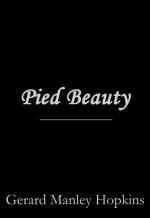|
This section contains 260 words (approx. 1 page at 400 words per page) |

|
Pied Beauty Summary & Study Guide Description
Pied Beauty Summary & Study Guide includes comprehensive information and analysis to help you understand the book. This study guide contains the following sections:
This detailed literature summary also contains Bibliography on Pied Beauty by Gerard Manley Hopkins.
The British poet Gerard Manley Hopkins is often described as an early modern poet ahead of his Victorian time. This is perhaps why, while he wrote “Pied Beauty” in 1877, in common with most of his other poetry, it was first published twenty-nine years after his death. It appeared in the first collected edition of his poems, Poems of Gerard Manley Hopkins, edited by Robert Bridges (1918). The poem subsequently appeared in the second complete edition of Hopkins’s poetry, published in 1930. As of 2006, “Pied Beauty” was available in Gerard Manley Hopkins: The Major Works, edited by Catherine Phillips (1986).
“Pied Beauty” is one of the first poems that Hopkins wrote in the so-called sprung rhythm that he evolved, based on the rhythms of Anglo-Saxon and ancient Welsh poetry. His aim was to approximate the rhythms and style of normal speech, albeit speech infused with a religious ecstasy and enthusiasm that are characteristics of his poetry. The poem also embodies Hopkins’s innovative use of condensed syntax and alliteration. It is written in the form of a curtal or shortened sonnet, another of Hopkins’s stylistic inventions. Thematically, the poem is a simple hymn of praise to God for the “dappled things” of creation. God is seen as being beyond change but as generating all the variety and opposites that manifest in the ever-changing world. Hopkins is best known as a nature poet and a religious poet, and “Pied Beauty” perfectly exemplifies both these aspects of his work.
Read more from the Study Guide
|
This section contains 260 words (approx. 1 page at 400 words per page) |

|



